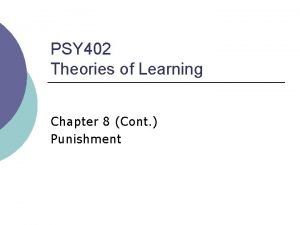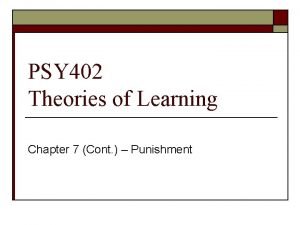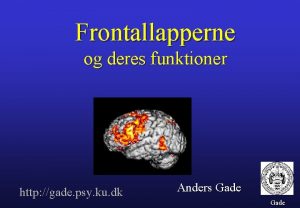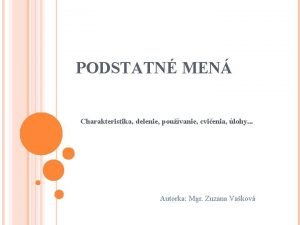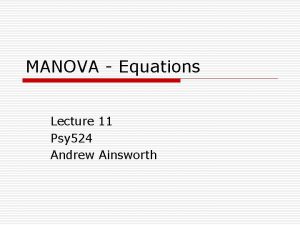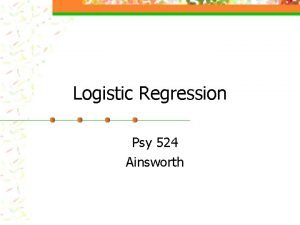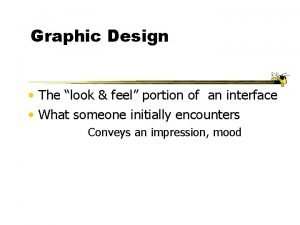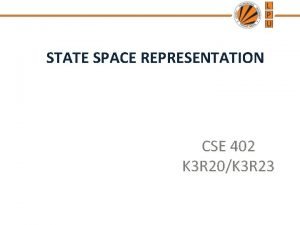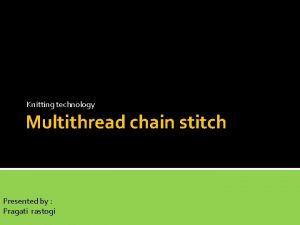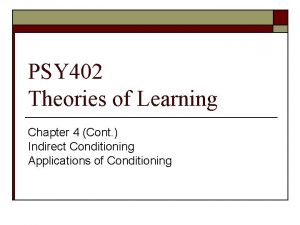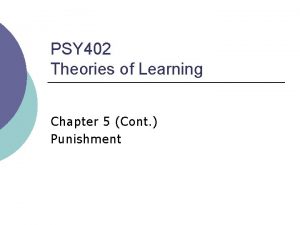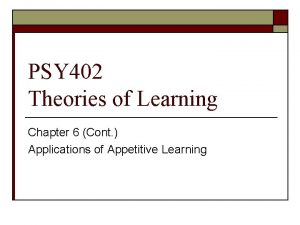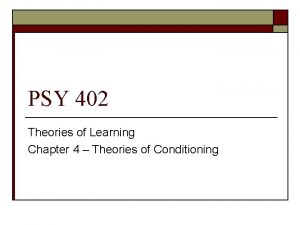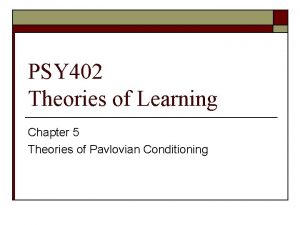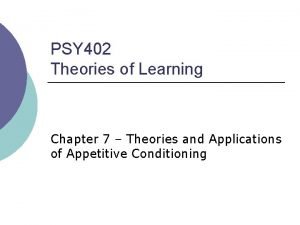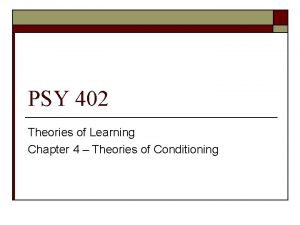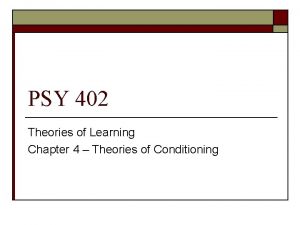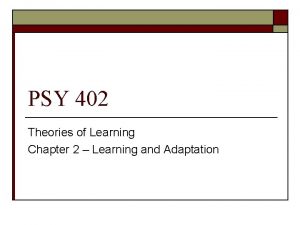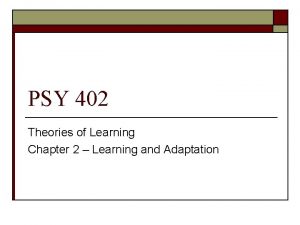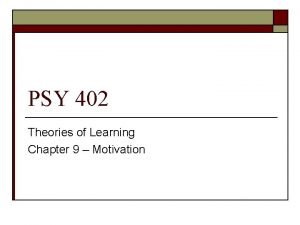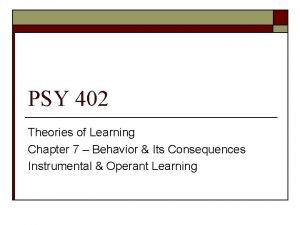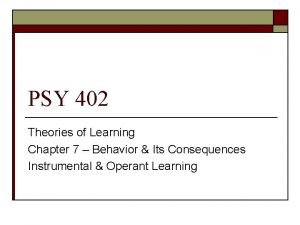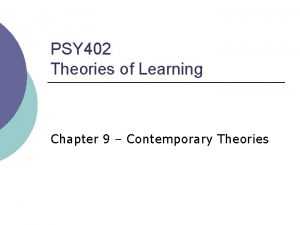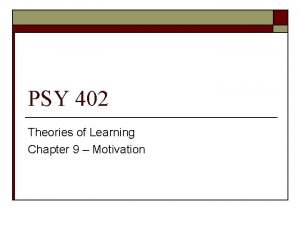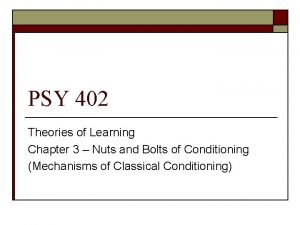PSY 402 Theories of Learning Chapter 7 Cont




























- Slides: 28

PSY 402 Theories of Learning Chapter 7 (Cont. ) – Punishment

Punishment o Use of an aversive event contingent on the occurrence of an inappropriate behavior. n o Used to suppress undesired behavior. If effective, frequency or intensity (or both) of behavior decreases.

Types of Punishers o o Positive punishment – use of a physically or psychologically painful event as a punisher. Negative punishment – loss of reinforcement as a consequence of an inappropriate behavior. n Also called omission training – reinforcement is provided when an undesirable behavior is withheld.

Positive reinforcement adds a good thing Negative reinforcement removes bad thing Increases Reinforcement + Behavior Consequences Punishment Reduces Punishment adds a bad thing Response cost removes good thing

Four Kinds of Consequences Positive Stimulus Negative Stimulus (Add) (Subtract) Increase Behavior Decrease Behavior Positive Reinforcement Negative Reinforcement Bonus for working hard leads to more hard work Headache gone after aspirin leads to more aspirin use Positive Punishment Negative Punishment Getting speeding ticket leads to less speeding Missing dinner leads to less staying out late

Types of Negative Punishment o Response cost – an undesirable behavior results in withdrawal of reward or failure to attain reward. n o Example: loss of privileges Time-out – a period of time during which reinforcement is unavailable. n Example: being sent to room after misbehaving.

Does Punishment Work? o o o Skinner showed that punishment only temporarily suppresses behavior. More recent studies show that it can permanently suppress behavior under some conditions. Under other conditions it has no effect or only temporarily works.

Punishment Works Temporarily Punished behavior returns

Severity of Punishment o Mild punishment doesn’t work. n o o With mild punishment, any suppression is short-lived. The more severe the punishment, the longer it works. n o Example: Drunk drivers do it again. Example: sale of cigarettes to minors. Must be severe to accomplish permanent behavior change.

Severity of Punishment Only higher shock levels work to suppress behavior

Consistency of Punishment o Punishment must be consistently administered. n n n Odds of a drunk driver being caught are 1 in 2000. Suppression increases as the frequency of punishment increases. Delinquent boys more likely to have parents who are inconsistent in their discipline.

Consistency of Punishment FR-1 means each behavior is punished FR-100 means 1 in 100 behaviors is punished

Delay of Punishment o Punishment must be immediate in order to be effective. n Long delay between arrest and trial for drunk drivers.

Delay of Punishment

Drawbacks to Using Punishment o Pain-induced aggression – pain elicits anger which may motivate aggressive behavior. n o An impulsive act energized by emotional arousal, not avoidance. Modeling of aggression – children may imitate a parent’s aggressive acts through observational learning. n Bandura’s Bobo doll study

Conditioning of Fear o The aversive quality of punishment may condition a fear response to the person administering it. n o Person will try to escape the punisher. Use of reinforcement together with punishment prevents this association. n Children do not learn to fear a behavior therapist who uses electric shock but also uses reinforcement.

More Drawbacks o Suppressive effects may generalize from an undesirable behavior to other desirable behaviors. n o Punishment may not generalize to similar undesirable behaviors. The person may not recognize the contingency between the behavior and the punishment.

Response Prevention & Flooding o o Phobias may be avoidance behavior motivated by fear. Flooding forces the person to experience the feared stimulus and associate the CS with the absence of the UCS, extinguishing fear. This leads to elimination of the avoidance behavior. Very effective, faster than other approaches.

Effectiveness of Flooding

More Applications of Punishment o o Widespread use of punishment (e. g. , spanking) probably does no serious harm. Two applications: n n o Persistent vomiting decreased. Chronic head-banging behavior suppressed. Use of such punishment may be preferable to ineffective methods.

Persistent Vomiting

Head Banging Intervention

Tree Climbing Behavior o o 6 -year old girl with hyperactivity Electric shock stopped the behavior during therapy but produced no change at home n o o Failure of generalization Use of the shock at home stopped the climbing at home. The mother felt this was more humane than repeated spankings, which didn’t work.

Controversies in Punishment o Is spanking ever beneficial? n n Many people were routinely spanked as kids. Spanking, when combined with other punishment and positive reinforcement may not be harmful. High levels of physical punishment in the home are associated with depression and conflict. Use of corporal punishment to control behavior can result in aggression and antisocial behavior, anxiety, depression, but only 1 desirable outcome.

Response Cost o o o Response cost is a form of negative punishment in which something is taken away for undesirable behavior. Capable of suppressing a wide variety of behaviors (smoking, thumb sucking, tardiness, aggressive behavior). May increase desirable behavior in the process (increased math accuracy, legibility).

Time-Out from Reinforcement o Time-out is a loss of access to reinforcement for a period of time as a consequence of bad behavior. n n The time-out must not be reinforcing – sending a child to his room is not punishment if it is full of toys. 10 min or 3 min time-outs reduce disruptive behaviors in preschool kids, adolescents.

Which Punishment? o o o Begin with the most socially acceptable and least intrusive (Alberto & Troutman). Level 1: differential reinforcement. Level 2: non-reinforcement Level 3: response cost, time-out Level 4: aversive stimuli (shock, paddling) or conditioned aversives (yelling, verbal warnings)

Ethical Use of Punishment o o Cruel and unusual punishments prohibited by 8 th Amendment of US Constitution. Rights of individual must be safeguarded. n n o APA Ethical Principles of Psychologists Least restrictive alternative Balance punisher pain against the resultant pain if the behavior is left untreated.
 Cont 402
Cont 402 Cont 402
Cont 402 Debriefing report
Debriefing report Cont or cont'd
Cont or cont'd Chapter 3 applying learning theories to healthcare practice
Chapter 3 applying learning theories to healthcare practice Euro psy
Euro psy Ucf industrial organizational psychology
Ucf industrial organizational psychology Psy2055
Psy2055 Psy 2055
Psy 2055 Psy 2055
Psy 2055 Psy
Psy Psy sanin
Psy sanin Psy
Psy Psy
Psy Psy
Psy Psy
Psy Psy 226
Psy 226 Psy
Psy Alla kulikova
Alla kulikova Psy ku
Psy ku Psy walsh
Psy walsh Najlepsi polovnicky pes
Najlepsi polovnicky pes Vzor gazdina
Vzor gazdina 11 psy
11 psy Regression psy
Regression psy Psy
Psy Psy 335 purdue
Psy 335 purdue Cse 402
Cse 402 401 stitch type
401 stitch type
